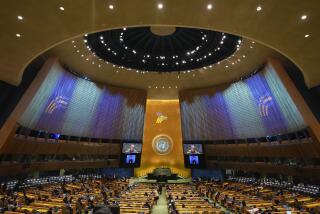START With the Lesson of Vladivostok
As Mikhail S. Gorbachev and Ronald Reagan struggle to cut the so-far elusive strategic-arms-reduction deal (START), the experts continue to bet against them. For my part, I’m not so sure. I’m down on my knees thinking of an earlier summit and begging whatever gods may be, “Please, no Vladivostok aide memoire. “
Ah, Vladivostok. Late November, 1974. The train, the snow, the conviviality, the half-dozen remaining SALT I issues. And finally the nuclear deal. “The most important agreement since the Magna Charta” (or something like that), said President Gerald Ford’s press secretary on the plane back to Japan.
I mused about this back in Washington where I was a nuclear-weapons specialist on Ford’s National Security Council staff, working on SALT II and waiting patiently for the boys to come home. The newspapers and cables had been a bit vague--just how had those key remaining issues I’d so carefully prepared for decision come out?
In a few days I had the answer: “The Russians are writing it up.” Alarm bells. “It’ll be called an aide memoire. “ More alarm bells; this was a term I had never heard of. (Basically, it means “memorandum.”)
But was there a deal or not? Where were the notes? Where was the President’s meeting book (with the half-dozen knotty issues and options cleanly summarized)? How did it all come out?
Before I got tired of chasing the notes and the meeting book, the aide memoire arrived. A single page (in English but clearly typed by the Soviets) signed by the Soviet ambassador to the United States, Anatoly F. Dobrynin, and Secretary of State Henry A. Kissinger. In it the United States agreed to limit the number of launchers of inter-continental ballistic missiles and ballistic missiles on submarines, heavy bombers and “air-to-surface missiles” with ranges over 600 kilometers, to an overall aggregate not to exceed 2,400. For the loss of a single word, this was an agreement that would in effect gut the Air Force’s air-launched cruise missile program, the key to maintaining the viability of the aging bomber leg of the sacrosanct U.S. strategic nuclear triad. It was a colossal screw-up.
The program--under which we planned to carry 12 to 20 long-range (2,000 kilometer) cruise missiles under or in the bomb bay of B-52s (and future bombers)--could not possibly go forward if SALT II required each air-to-surface cruise missile over 600 kilometers to be counted as “one” in the 2,400 aggregate.
It was an old Soviet position, designed to kill the air-launched cruise missile by grouping it in limits with all air-to-surface ballistic missiles. It had never been taken seriously by our side. And cruise missile limits were not even supposed to be discussed at Vladivostok--in part because of their contemplated use in conventional and tactical nuclear roles, and in part because of far more demanding verification requirements.
We did for certain expect to limit air-to-surface ballistic missiles in the 2,400 figure, even though neither we nor the Soviets had such a system. But Boeing and others had ideas for carrying them on transport aircraft. In fact, just a few months earlier we had demonstrated it could be done with a Minuteman I ICBM dropped from the back of a C-5 at about 30,000 feet.
Though Kissinger plaintively inquired as to whether the air-launched cruise missile program was really that necessary, it didn’t take long to convince people that the agreement had to be fixed. This was a deal no one was going to take to the Pentagon, much less to Congress.
But the Soviets wouldn’t budge. It turned out that a first draft of the aide memoire had come to the White House a couple of days before I saw it. Kissinger and Brent Scowcroft, his deputy national security adviser, had reviewed it and suggested a few changes in the text--but not adding the crucial word ballistic . The Soviets had accepted the changes and prepared the final draft that had then been signed. A deal was a deal.
I’ll never forget the groans when I broke the news to my colleagues in the SALT II working group--that the damning language remained unchanged, that Kissinger had abandoned the renegotiation effort with Dobrynin and that we’d have to work it all out at the formal negotiations in Geneva--a “technical detail.”
The story gets even sadder. In Geneva the Soviets were intransigent; they had the signed piece of paper. After a time we tried compromises--other limits on air-launched cruise missiles--but this forced consideration of a whole new set of limits and verification issues relating to other kinds of cruise missiles. Deadlock set in--and stayed.
In the end Ford never got the SALT deal that sounded so good on the train in the snow, and he may have lost the presidency in 1976 because of it. I never got anyone’s notes or the interpreter’s “memoranda of conversation” of the meeting, even though I stayed through the Jimmy Carter Administration and tried several times to see them. A friend saw them once and said that both the President and Kissinger were real sloppy, either could be blamed. Or no one. It was just a lost opportunity--another unneeded setback at a time when a step forward by the superpowers might have gotten the world onto a safer path.
Today there is a promise of real strategic nuclear arms reductions that people out there want to believe in. And there’s a correlation of forces--and people--right now, that doesn’t come often for the superpowers, or for you and me. But you either have a deal or you don’t.
Please, no Vladivostok aide memoire.
More to Read
Sign up for Essential California
The most important California stories and recommendations in your inbox every morning.
You may occasionally receive promotional content from the Los Angeles Times.










